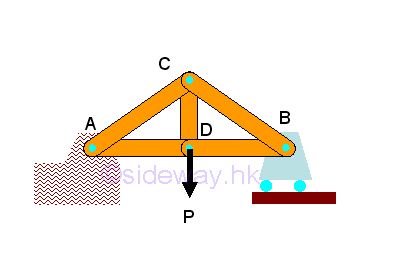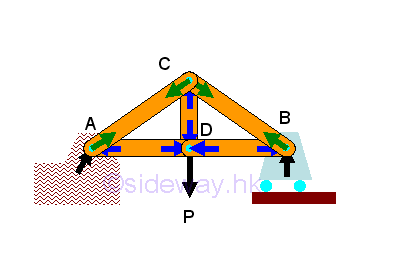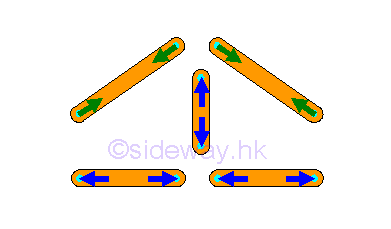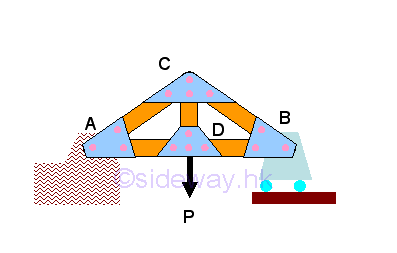Truss

Truss is one of the most common type of engineering structure, e.g. bridges and building. A truss is only constructed with straight members connected at connecting joints by hinge pins located at the two ends of each member. A frictionless pin at the joint implys no rotational motion is transmitted through the joint. No member in the truss is continuous through a joint. Therefore, member in the truss behaves like a short link and only tensile and compressive force can be transmitted between the end joints in static equilibrium.

Since forces can only be applied at the joints of a member, a truss member is a two-force member.

Usually, gusset plates are used for connecting the intersecting elements at the joint to eliminate the assembly sequence problem or may be in sometimes make the structure more stable. Although the original joint design of a truss is a fictionless hinge pin, truss member can also be rigidly connected because there is little impact of the force flow in a completely constrained and kinematically determinate structure. Since when designing a truss, the axial stiffness of the truss members is already sufficiently large enough to maintain the structure in the stable working condition and to ensure the bending restraint required at the connecting joint is negligible also.

In truss structure design, the truss members are relatively slender for providing axial stiffness only. Since the truss members are not design for supporting lateral load, all loading can only be applied to the joint. Therefore, a system of stringers and cross beams are needed for any loading which cannot be applied onto the joints. For example, truss subject to a distributed load, or a concentrated load between two joints.
In general, the weight of member is much smaller that the member axial force, the weight of member can often be neglected. However, when the member weight should be considered, the member weight can be assumed to be shared as loadings that being applied to the joints at two ends of the member.
©sideway
ID: 120200069 Last Updated: 3/12/2012 Revision: 1 Ref:
References
- I.C. Jong; B.G. rogers, 1991, Engineering Mechanics: Statics and Dynamics
- F.P. Beer; E.R. Johnston,Jr.; E.R. Eisenberg, 2004, Vector Mechanics for Engineers: Statics
Latest Updated Links
- Legrand Galion(last updated On 12/2/2025)
- Schneider Electric AvatarOn(last updated On 12/1/2025)
- Alfalux(last updated On 11/30/2025)
- Novabell(last updated On 11/29/2025)
- TownGas NJW12RM1(last updated On 11/28/2025)
- SamSung 42" OLED TV S90F 4K(last updated On 11/27/2025)
- Tefal KI7208 GLASS VISION KETTLE(last updated On 11/26/2025)
- Tefal BL83SD PerfectMix Cook Blender(last updated On 11/25/2025)
- Tefal KI7208 GLASS VISION KETTLE(last updated On 11/24/2025)
- Hitachi RD-290GX Dehumidifier(last updated On 11/23/2025)
- Hitachi RD-290GX Dehumidifier(last updated On 11/22/2025)

 Nu Html Checker
Nu Html Checker  53
53  na
na  na
na
Home 5
Business
Management
HBR 3
Information
Recreation
Hobbies 9
Culture
Chinese 1097
English 339
Travel 18
Reference 79
Hardware 54
Computer
Hardware 259
Software
Application 213
Digitization 37
Latex 52
Manim 205
KB 1
Numeric 19
Programming
Web 289
Unicode 504
HTML 66
CSS 65
SVG 46
ASP.NET 270
OS 431
DeskTop 7
Python 72
Knowledge
Mathematics
Formulas 8
Set 1
Logic 1
Algebra 84
Number Theory 206
Trigonometry 31
Geometry 34
Calculus 67
Engineering
Tables 8
Mechanical
Rigid Bodies
Statics 92
Dynamics 37
Fluid 5
Control
Acoustics 19
Natural Sciences
Matter 1
Electric 27
Biology 1
